#ngc 6165
Text
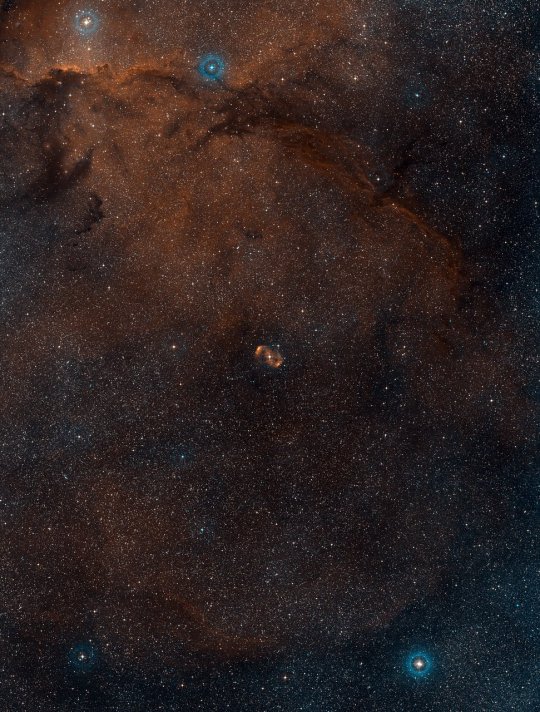
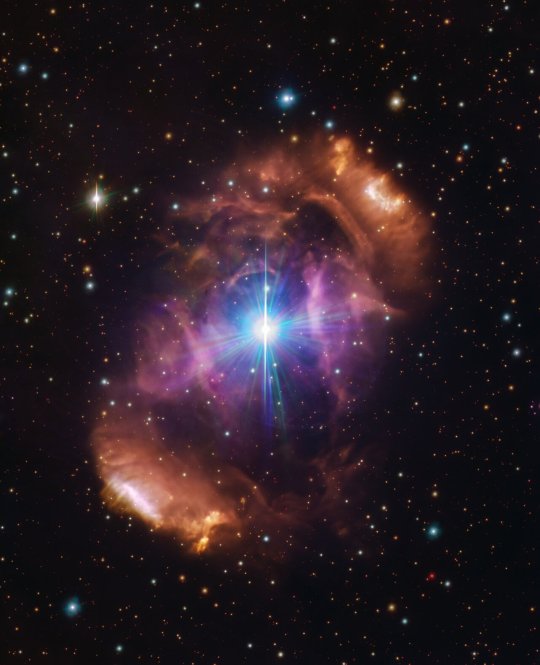
Dragon's egg embracing the Blue Star © ESO
#space#astrophotography#ESO#ngc 6165#dragon's egg#solar system#stars#night sky#astronomy#universe#galaxy#planet#cosmos
603 notes
·
View notes
Text
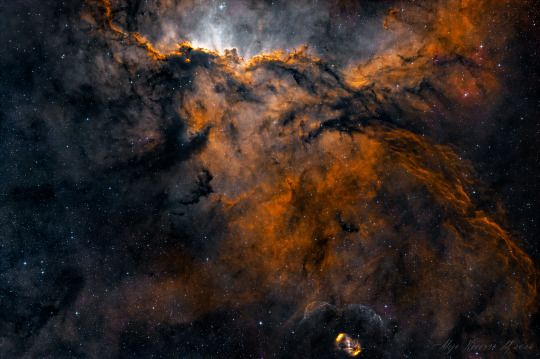
The Dragons of Ara (NGC 6188) guarding the Dragon's Egg (NGC 6164/5, bottom) // Alejandro Navarro
#astronomy#astrophotography#nebula#emission nebula#star-forming region#dragons of ara#dragon's egg#NGC 6188#NGC 6164#NGC 6165#ara
110 notes
·
View notes
Text

Un articolo pubblicato sulla rivista "Science" riporta uno studio sul sistema HD 148937, un sistema binario circondato da una doppia nebulosa conosciuta come NGC 6164/6165. Un team di ricercatori ha usato gli strumenti PIONIER e GRAVITY montati sull'interferometro del VLT (VLTI) dell'ESO in Cile e dati dell'archivio dello strumento FEROS all'Osservatorio di La Silla, anch'esso dell'ESO in Cile, per raccogliere i dati necessari a concludere che in origine si trattava almeno di un sistema triplo e a un certo punto due delle stelle si sono fuse. Si è trattato di un evento violento che ha creato la nube di materiali attorno al sistema.
2 notes
·
View notes
Text
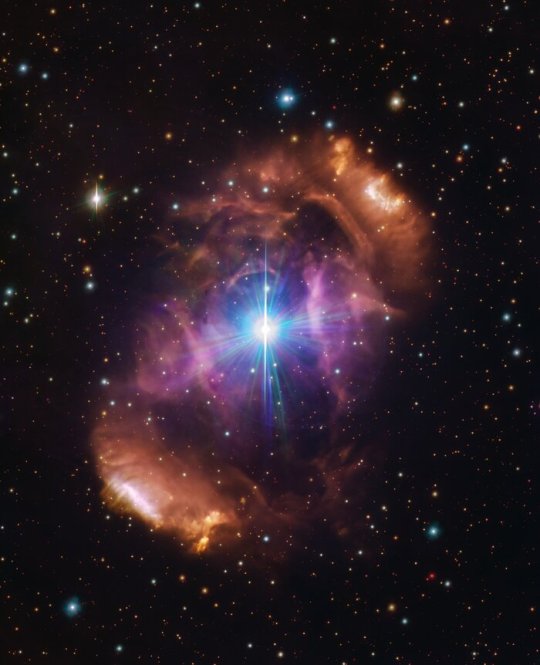
This image, taken with the VLT Survey Telescope hosted at ESO’s Paranal Observatory, shows the beautiful nebula NGC 6164/6165, also known as the Dragon’s Egg. The nebula is a cloud of gas and dust surrounding a pair of stars called HD 148937.
In a new study using ESO data, astronomers have shown that the two stars are unusually different from each other — one appears much younger and, unlike the other, is magnetic. Moreover, the nebula is significantly younger than either star at its heart, and is made up of gases normally found deep within a star and not on the outside. These clues together helped solve the mystery of the HD 148937 system — there were most likely three stars in the system until two of them clashed and merged, creating a new, larger and magnetic star. This violent event also created the spectacular nebula that now surrounds the remaining stars. Credit:
Credit: ESO
850 notes
·
View notes
Text

Beautiful nebula, violent history: Clash of stars solves stellar mystery
When astronomers looked at a stellar pair at the heart of a stunning cloud of gas and dust, they were in for a surprise. Star pairs are typically very similar, like twins, but in HD 148937, one star appears younger and, unlike the other, is magnetic.
New data from the European Southern Observatory (ESO) suggest there were originally three stars in the system, until two of them clashed and merged. This violent event created the surrounding cloud and forever altered the system's fate.
"When doing background reading, I was struck by how special this system seemed," says Abigail Frost, an astronomer at ESO in Chile and lead author of the study, "A magnetic massive star has experienced a stellar merger," published in Science.
The system, HD 148937, is located about 3800 light-years away from Earth in the direction of the Norma constellation. It is made up of two stars much more massive than the sun and surrounded by a beautiful nebula, a cloud of gas and dust. "A nebula surrounding two massive stars is a rarity, and it really made us feel like something cool had to have happened in this system. When looking at the data, the coolness only increased."
"After a detailed analysis, we could determine that the more massive star appears much younger than its companion, which doesn't make any sense since they should have formed at the same time," Frost says. The age difference—one star appears to be at least 1.5 million years younger than the other—suggests something must have rejuvenated the more massive star.
Another piece of the puzzle is the nebula surrounding the stars, known as NGC 6164/6165. It is 7,500 years old, hundreds of times younger than both stars. The nebula also shows very high amounts of nitrogen, carbon and oxygen. This is surprising as these elements are normally expected deep inside a star, not outside; it is as if some violent event had set them free.
To unravel the mystery, the team assembled nine years' worth of data from the PIONIER and GRAVITY instruments, both on ESO's Very Large Telescope Interferometer (VLTI), located in Chile's Atacama Desert. They also used archival data from the FEROS instrument at ESO's La Silla Observatory.
"We think this system had at least three stars originally; two of them had to be close together at one point in the orbit while another star was much more distant," explains Hugues Sana, a professor at KU Leuven in Belgium and the principal investigator of the observations.
"The two inner stars merged in a violent manner, creating a magnetic star and throwing out some material, which created the nebula. The more distant star formed a new orbit with the newly merged, now-magnetic star, creating the binary we see today at the center of the nebula."
"The merger scenario was already in my head back in 2017 when I studied nebula observations obtained with the European Space Agency's Herschel Space Telescope," adds co-author Laurent Mahy, currently a senior researcher at the Royal Observatory of Belgium.
"Finding an age discrepancy between the stars suggests that this scenario is the most plausible one and it was only possible to show it with the new ESO data."
This scenario also explains why one of the stars in the system is magnetic and the other is not—another peculiar feature of HD 148937 spotted in the VLTI data.
At the same time, it helps solve a long-standing mystery in astronomy: how massive stars get their magnetic fields. While magnetic fields are a common feature of low-mass stars like our sun, more massive stars cannot sustain magnetic fields in the same way. Yet some massive stars are indeed magnetic.
Astronomers had suspected for some time that massive stars could acquire magnetic fields when two stars merge. But this is the first time researchers find such direct evidence of this happening. In the case of HD 148937, the merger must have happened recently.
"Magnetism in massive stars isn't expected to last very long compared to the lifetime of the star, so it seems we have observed this rare event very soon after it happened," Frost adds.
ESO's Extremely Large Telescope (ELT), currently under construction in the Chilean Atacama Desert, will enable researchers to work out what happened in the system in more detail, and perhaps reveal even more surprises.
IMAGE....This image, taken with the VLT Survey Telescope hosted at ESO's Paranal Observatory, shows the beautiful nebula NGC 6164/6165, also known as the Dragon's Egg. The nebula is a cloud of gas and dust surrounding a pair of stars called HD 148937. Credit: ESO/VPHAS+ team. Acknowledgement: CASU
15 notes
·
View notes
Text
https://www.reuters.com/science/astronomers-unravel-mystery-dragons-egg-nebula-2024-04-11/
Astronomers unravel the mystery of the 'Dragon's Egg' nebula

The nebula NGC 6164/6165, also known as the Dragon's Egg, a cloud of gas and dust surrounding a pair of stars called HD 148937, is seen in this undated handout image taken with the VLT Survey Telescope hosted at the European Southern Observatory's Paranal Observatory in Cerro Paranal, Chile.
WASHINGTON, April 11 (Reuters) - Two large stars residing inside a spectacular cloud of gas and dust nicknamed the "Dragon's Egg" nebula have presented a puzzle to astronomers. One of them has a magnetic field, as does our sun. Its companion does not. And such massive stars are not usually associated with nebulae.
Researchers now appear to have resolved this mystery while also explaining how the relatively few massive stars that are magnetic got that way. Blame it on stellar fratricide, they said. In this case, the bigger star apparently gobbled up a smaller sibling star, and the mixing of their stellar material during this hostile takeover created a magnetic field.
"This merger was likely very violent. When two stars merge, material can be thrown out, and this likely created the nebula we see today," said Chile-based European Southern Observatory astronomer Abigail Frost, lead author of the study published on Thursday in the journal Science.
Computer simulations previously had predicted that the blending of stellar material during such a merger could create a magnetic field in the combined star born in this process.
"Our study is the observational smoking gun confirming this scenario," said astronomer Hugues Sana of KU Leuven in Belgium, the study's senior author.
These two stars - gravitationally bound to each other in what is called a binary system - are located in our Milky Way galaxy about 3,700 light-years from Earth in the constellation Norma. A light-year is the distance light travels in a year, 5.9 trillion miles (9.5 trillion km).
The researchers used nine years of observations by the Chile-based Very Large Telescope.
The magnetic star is about 30 times more massive than the sun. Its remaining companion is about 26.5 times more massive than the sun. They orbit at a distance from each other varying from seven to 60 times the distance between Earth and the sun.
The Dragon's Egg is so named because it is located relatively near a larger nebula complex called the Fighting Dragons of Ara. The stars inside the Dragon's Egg appear to have started out 4-6 million years ago as a triple system - three stars born at the same time and gravitationally bound.
The triple system's two innermost members included a larger star - perhaps 25 to 30 times the mass of the sun - and a smaller one - maybe five to 10 times the sun's mass.
The more massive one evolved more quickly than the other, with its outer layer engulfing the smaller star and triggering a merger that ejected into space the gas and dust that make up the nebula, the researchers said.
This occurred very recently in a cosmic time scale - about 7,500 years ago, based on the expansion velocity of the material in the nebula. It consists of mostly hydrogen and helium, but also an unusually large amount of nitrogen, thanks to the merger.
Many sun-sized stars generate magnetic fields.
"For low-mass stars like our sun, convective heating - like the movement of hot water in a radiator in your home - creates a movement of stellar material. This in turn creates a dynamo effect which induces a magnetic field," Frost said.
"However, for massive stars - greater than eight times the mass of our sun - different heating effects are in play, and so explaining the presence of magnetic fields for these types of stars is more tricky. This merger scenario ticks all the boxes," Frost added.
About 7% of massive stars are known to have a magnetic field. The second star in this binary system, uninvolved in the violent merger, does not.
Stellar magnetic fields store immense amounts of energy. The sun's magnetic storms can interact with Earth's atmosphere and create our planet's thrilling auroras, but also can disrupt radio signals and navigation systems.
An image of the nebula released with the study is visually striking.
"The richness of the physics and chemistry at play gave rise to a beautiful structure," Sana said.
2 notes
·
View notes
Text
Bella nebulosa con una storia violenta
Questa immagine, scattata con il VLT Survey Telescope ospitato presso l’Osservatorio Paranal dell’ESO, mostra la bellissima nebulosa NGC 6164/6165, nota anche come Uovo del Drago. La nebulosa è una nube di gas e polvere che circonda una coppia di stelle chiamata HD 148937.
Quando gli astronomi hanno osservato una coppia stellare nel cuore di una straordinaria nube di gas e polvere, hanno avuto…

View On WordPress
0 notes
Text
ESO: Merger of 2 stars creates a magnetic star and a nebula
The latest report from the European Southern Observatory (ESO):
Beautiful nebula, violent history:
clash of stars solves stellar mystery

This image, taken with the VLT Survey Telescope hosted at ESO’s Paranal Observatory, shows the beautiful nebula NGC 6164/6165, also known as the Dragon’s Egg. The nebula is a cloud of gas and dust surrounding a pair of stars called HD 148937. In a new study using ESO data, astronomers have shown that the two stars are unusually different from each other — one appears much younger and, unlike the other, is magnetic. Moreover, the nebula is significantly younger than either star at its heart, and is made up of gases normally found deep within a star and not on the outside. These clues together helped solve the mystery of the HD 148937 system — there were most likely three stars in the system until two of them clashed and merged, creating a new, larger and magnetic star. This violent event also created the spectacular nebula that now surrounds the remaining stars.
Credit: ESO/VPHAS+ team. Acknowledgement: CASU
When astronomers looked at a stellar pair at the heart of a stunning cloud of gas and dust, they were in for a surprise. Star pairs are typically very similar, like twins, but in HD 148937, one star appears younger and, unlike the other, is magnetic. New data from the European Southern Observatory (ESO) suggest there were originally three stars in the system, until two of them clashed and merged. This violent event created the surrounding cloud and forever altered the system’s fate.
“When doing background reading, I was struck by how special this system seemed,”
says Abigail Frost, an astronomer at ESO in Chile and lead author of the study published today in Science. The system, HD 148937, is located about 3800 light-years away from Earth in the direction of the Norma constellation. It is made up of two stars much more massive than the Sun and surrounded by a beautiful nebula, a cloud of gas and dust.
“A nebula surrounding two massive stars is a rarity, and it really made us feel like something cool had to have happened in this system. When looking at the data, the coolness only increased.”
https://youtu.be/1pPnHX4YukE
“After a detailed analysis, we could determine that the more massive star appears much younger than its companion, which doesn't make any sense since they should have formed at the same time!”
The age difference — one star appears to be at least 1.5 million years younger than the other — suggests something must have rejuvenated the more massive star.
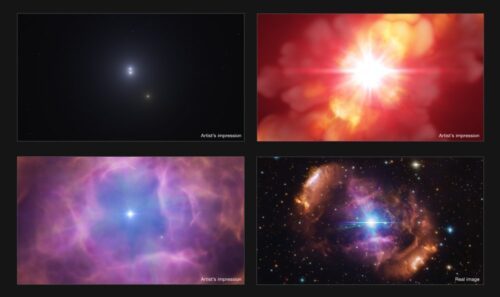
This collection of panels shows three artist’s impressions depicting the violent event that changed the fate of the stellar system HD 148937; a real astronomical image is shown in the last panel. Originally, the system had at least three stars (top left panel), two of them close together and another one much more distant, until one day the two inner stars clashed and merged (top right panel). This violent event created a new, larger and magnetic star, now in a pair with the more distant one (bottom left panel). The merger also released the materials that created the spectacular nebula now surrounding the stars (bottom right panel).Credit: ESO/L. Calçada, VPHAS+ team. Acknowledgement: CASU
Another piece of the puzzle is the nebula surrounding the stars, known as NGC 6164/6165. It is 7500 years old, hundreds of times younger than both stars. The nebula also shows very high amounts of nitrogen, carbon and oxygen. This is surprising as these elements are normally expected deep inside a star, not outside; it is as if some violent event had set them free.
To unravel the mystery, the team assembled nine years' worth of data from the PIONIER and GRAVITY instruments, both on ESO’s Very Large Telescope Interferometer (VLTI), located in Chile’s Atacama Desert. They also used archival data from the FEROS instrument at ESO’s La Silla Observatory.
“We think this system had at least three stars originally; two of them had to be close together at one point in the orbit whilst another star was much more distant,”
explains Hugues Sana, a professor at KU Leuven in Belgium and the principal investigator of the observations.
“The two inner stars merged in a violent manner, creating a magnetic star and throwing out some material, which created the nebula. The more distant star formed a new orbit with the newly merged, now-magnetic star, creating the binary we see today at the centre of the nebula.”
https://youtu.be/DfYV0cZ9Ym0
“The merger scenario was already in my head back in 2017 when I studied nebula observations obtained with the European Space Agency’s Herschel Space Telescope,”
“Finding an age discrepancy between the stars suggests that this scenario is the most plausible one and it was only possible to show it with the new ESO data.”
This scenario also explains why one of the stars in the system is magnetic and the other is not — another peculiar feature of HD 148937 spotted in the VLTI data.
At the same time, it helps solve a long-standing mystery in astronomy: how massive stars get their magnetic fields. While magnetic fields are a common feature of low-mass stars like our Sun, more massive stars cannot sustain magnetic fields in the same way. Yet some massive stars are indeed magnetic.
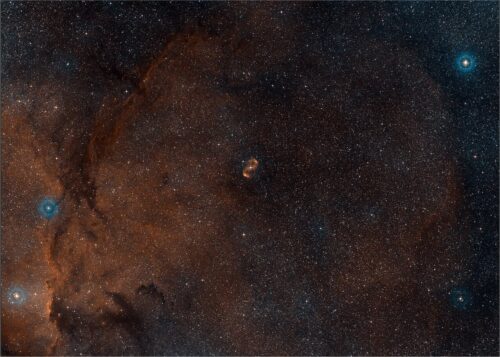
This wide-field view, created from images forming part of the Digitized Sky Survey 2, shows the rich star clouds in the constellation of Norma (the Carpenter’s Square) in our Milky Way galaxy. The beautiful nebula NGC 6164/6165, also known as the Dragon’s Egg, appears in the centre of the image. Credit: ESO/Digitized Sky Survey 2. Acknowledgement: Davide De Martin
Astronomers had suspected for some time that massive stars could acquire magnetic fields when two stars merge. But this is the first time researchers find such direct evidence of this happening. In the case of HD 148937, the merger must have happened recently.
“Magnetism in massive stars isn't expected to last very long compared to the lifetime of the star, so it seems we have observed this rare event very soon after it happened,”
Frost adds.
ESO’s Extremely Large Telescope (ELT), currently under construction in the Chilean Atacama Desert, will enable researchers to work out what happened in the system in more detail, and perhaps reveal even more surprises.
Links
- Research paper (preprint; for the final version of the embargoed paper, please check https://www.eurekalert.org/press/scipak/ or contact [email protected] while the embargo lasts)
- Photos of the VLT/VLTI
- Find out more about ESO's Extremely Large Telescope on our dedicated website and press kit
- For journalists: subscribe to receive our releases under embargo in your language
- For scientists: got a story? Pitch your research
=== Amazon Ads ===
Celestron - NexStar 130SLT Computerized Telescope -
Compact and Portable -
Newtonian Reflector Optical Design -
SkyAlign Technology -
Computerized Hand Control -
130mm Aperture
====
An Infinity of Worlds:
Cosmic Inflation and the Beginning of the Universe
Read the full article
0 notes
Text

The Fight Dragons of Ara (NGC 6188, left) guarding the Dragon's Egg (NGC 6164/6165, lower right) // Fábio Andrade de Moura
#astronomy#astrophotography#nebula#emission nebula#star-forming region#fighting dragons of ara#dragons of ara#dragon's egg#NGC 6188#NGC 6164#NGC 6165#ara
31 notes
·
View notes
Text

The Dragon's Egg, NGC 6164 & NGC 6165 // Karl-Heinz
141 notes
·
View notes
Text
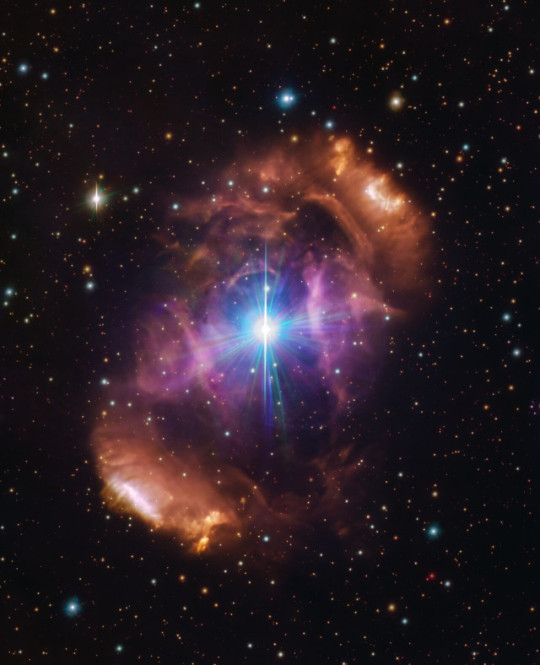
An article published in the journal "Science" reports a study on the HD 148937 system, a binary system surrounded by a double nebula known as NGC 6164/6165. A team of researchers used the PIONIER and GRAVITY instruments mounted on ESO's VLT Interferometer (VLTI) in Chile and archival data from the FEROS instrument at the La Silla Observatory, also an ESO's telescope in Chile, to collect the data necessary to conclude that it was originally at least a triple system and at some point two of the stars merged. It was a violent event that created the cloud of materials around the system.
13 notes
·
View notes
Text
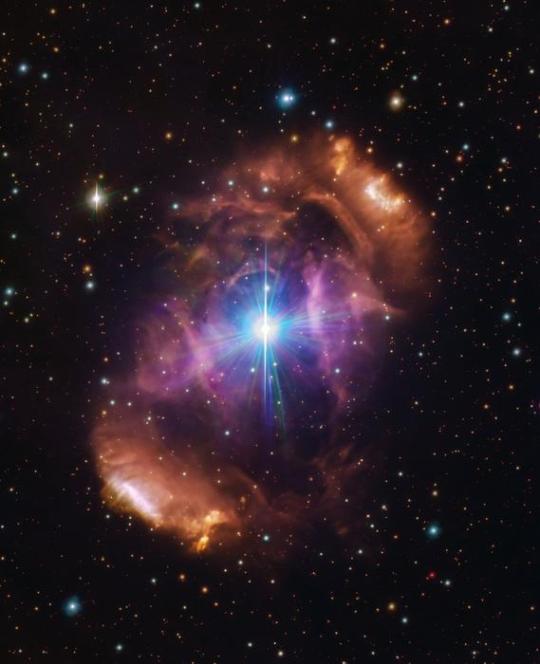
Beautiful nebula, violent history: Clash of stars solves stellar mystery
When astronomers looked at a stellar pair at the heart of a stunning cloud of gas and dust, they were in for a surprise. Star pairs are typically very similar, like twins, but in HD 148937, one star appears younger and, unlike the other, is magnetic. New data from the European Southern Observatory (ESO) suggest there were originally three stars in the system, until two of them clashed and merged. This violent event created the surrounding cloud and forever altered the system’s fate.
“When doing background reading, I was struck by how special this system seemed,” says Abigail Frost, an astronomer at ESO in Chile and lead author of the study published today in Science. The system, HD 148937, is located about 3800 light-years away from Earth in the direction of the Norma constellation. It is made up of two stars much more massive than the Sun and surrounded by a beautiful nebula, a cloud of gas and dust. “A nebula surrounding two massive stars is a rarity, and it really made us feel like something cool had to have happened in this system. When looking at the data, the coolness only increased.”
“After a detailed analysis, we could determine that the more massive star appears much younger than its companion, which doesn't make any sense since they should have formed at the same time!” Frost says. The age difference — one star appears to be at least 1.5 million years younger than the other — suggests something must have rejuvenated the more massive star.
Another piece of the puzzle is the nebula surrounding the stars, known as NGC 6164/6165. It is 7500 years old, hundreds of times younger than both stars. The nebula also shows very high amounts of nitrogen, carbon and oxygen. This is surprising as these elements are normally expected deep inside a star, not outside; it is as if some violent event had set them free.
To unravel the mystery, the team assembled nine years' worth of data from the PIONIER and GRAVITY instruments, both on ESO’s Very Large Telescope Interferometer (VLTI), located in Chile’s Atacama Desert. They also used archival data from the FEROS instrument at ESO’s La Silla Observatory.
“We think this system had at least three stars originally; two of them had to be close together at one point in the orbit whilst another star was much more distant,” explains Hugues Sana, a professor at KU Leuven in Belgium and the principal investigator of the observations. “The two inner stars merged in a violent manner, creating a magnetic star and throwing out some material, which created the nebula. The more distant star formed a new orbit with the newly merged, now-magnetic star, creating the binary we see today at the centre of the nebula.”
“The merger scenario was already in my head back in 2017 when I studied nebula observations obtained with the European Space Agency’s Herschel Space Telescope,” adds co-author Laurent Mahy, currently a senior researcher at the Royal Observatory of Belgium. “Finding an age discrepancy between the stars suggests that this scenario is the most plausible one and it was only possible to show it with the new ESO data.”
This scenario also explains why one of the stars in the system is magnetic and the other is not — another peculiar feature of HD 148937 spotted in the VLTI data.
At the same time, it helps solve a long-standing mystery in astronomy: how massive stars get their magnetic fields. While magnetic fields are a common feature of low-mass stars like our Sun, more massive stars cannot sustain magnetic fields in the same way. Yet some massive stars are indeed magnetic.
Astronomers had suspected for some time that massive stars could acquire magnetic fields when two stars merge. But this is the first time researchers find such direct evidence of this happening. In the case of HD 148937, the merger must have happened recently. “Magnetism in massive stars isn't expected to last very long compared to the lifetime of the star, so it seems we have observed this rare event very soon after it happened,” Frost adds.
ESO’s Extremely Large Telescope (ELT), currently under construction in the Chilean Atacama Desert, will enable researchers to work out what happened in the system in more detail, and perhaps reveal even more surprises.
IMAGE.....This image, taken with the VLT Survey Telescope hosted at ESO’s Paranal Observatory, shows the beautiful nebula NGC 6164/6165, also known as the Dragon’s Egg. The nebula is a cloud of gas and dust surrounding a pair of stars called HD 148937. In a new study using ESO data, astronomers have shown that the two stars are unusually different from each other — one appears much younger and, unlike the other, is magnetic. Moreover, the nebula is significantly younger than either star at its heart, and is made up of gases normally found deep within a star and not on the outside. These clues together helped solve the mystery of the HD 148937 system — there were most likely three stars in the system until two of them clashed and merged, creating a new, larger and magnetic star. This violent event also created the spectacular nebula that now surrounds the remaining stars. Credit ESO/VPHAS+ team. Acknowledgement: CASU
3 notes
·
View notes
Photo

NGC 6165 // Nik Szymanek
41 notes
·
View notes
Photo
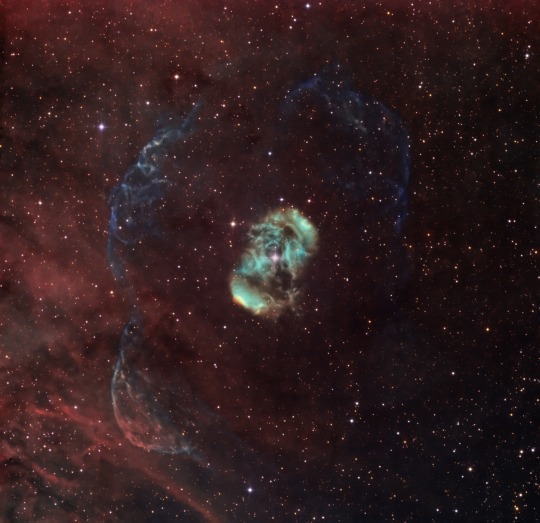
NGC 6165 // Nik Szymanek
34 notes
·
View notes
Photo

NGC 6165 // Rodrigo Vera
8 notes
·
View notes